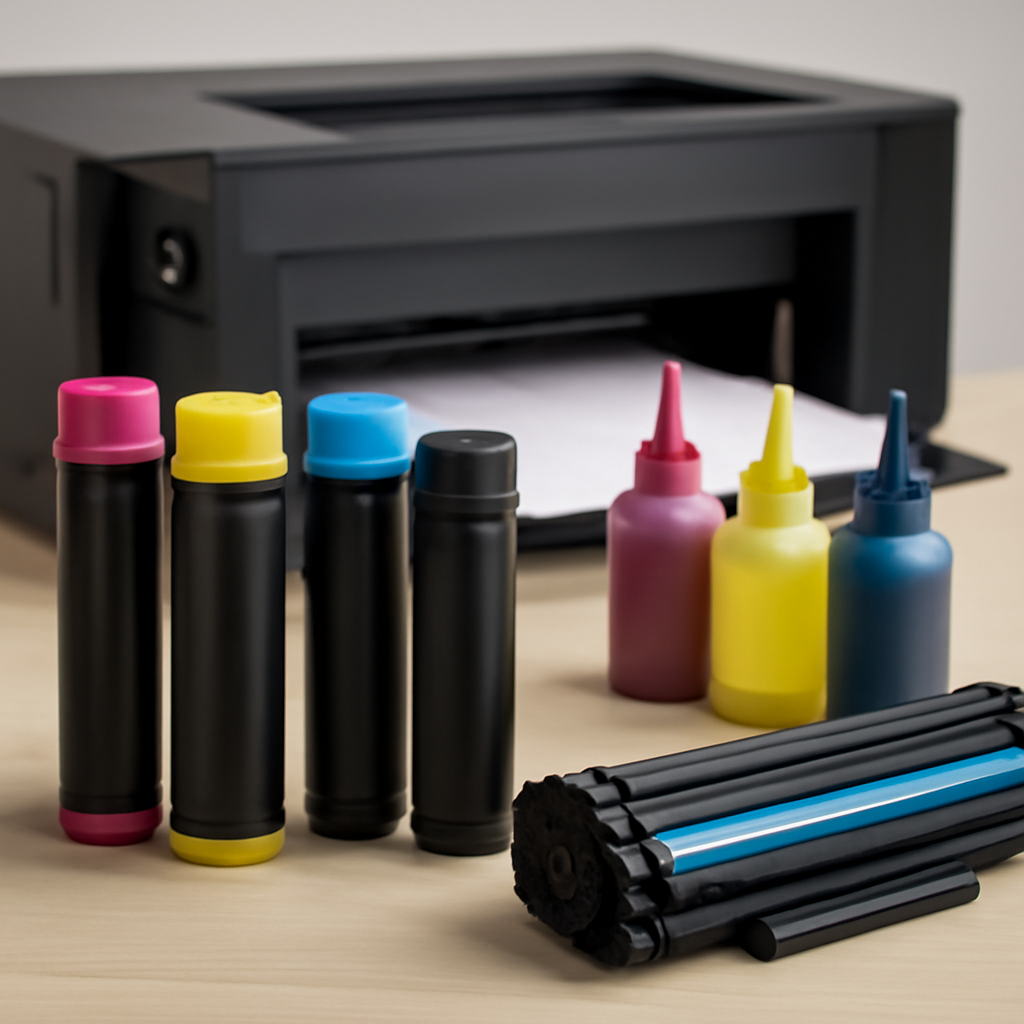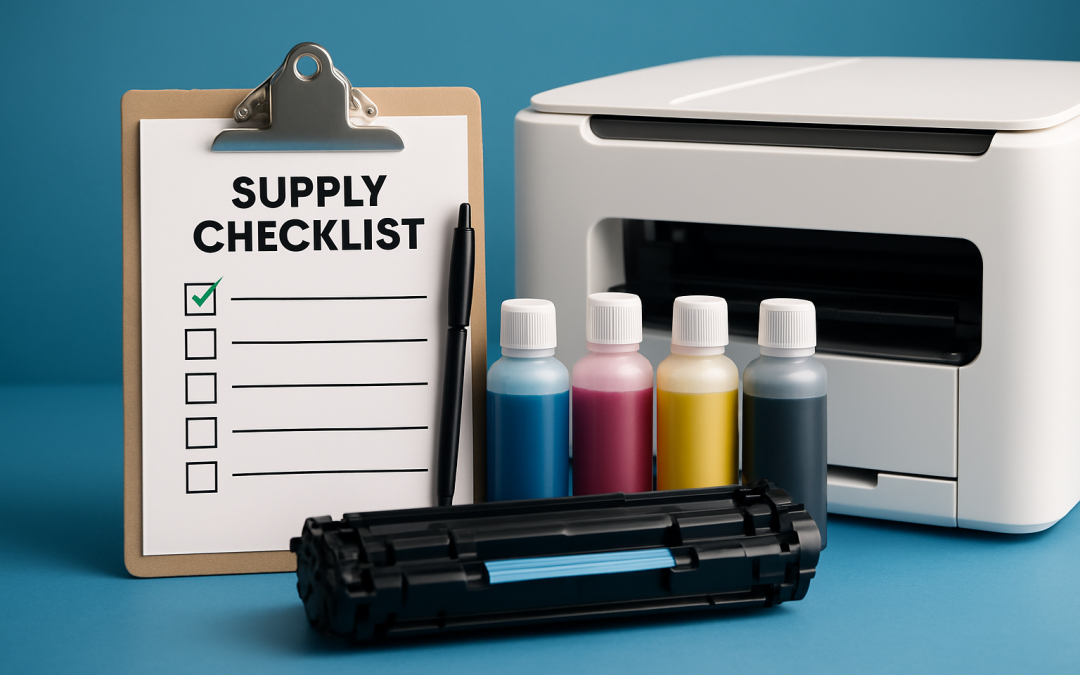The Complete Printer Consumables Supply Checklist: Ensure Seamless Printing for Your Business
When your team relies on documents to move work forward, a disciplined approach to printer consumables supply becomes the difference between confident momentum and frustrating downtime. Think about the last time a toner ran out mid-proposal or a maintenance kit warning appeared right before a deadline: the costs extended far beyond a single cartridge. They touched productivity, client confidence, and staff morale. Industry surveys suggest printing interruptions can consume 1 to 3 percent of revenue through lost time, reprints, and emergency purchases. With the right checklist, forecasting, and vendor strategy, you can turn this cost center into a controlled, predictable workflow. In this guide, you will find a practical, step-by-step list, cost comparisons, reorder calculations, and maintenance best practices, plus ways Printcom aligns multi-brand fleets under one service umbrella. As you read, visualize a simple flow: assess devices, standardize supplies, forecast usage, automate reordering, and verify through monthly reviews. Ready to make printing as reliable as turning on the lights?
Why Planning Your Printer Consumables Supply Protects Uptime
Unplanned stock-outs usually strike at peak moments, and they compound fast. A missing drum unit can idle a whole floor, while last-minute courier fees inflate costs by 20 to 40 percent compared with planned orders, according to procurement benchmarks. The good news is that most of this is avoidable with a structured plan anchored to device duty cycles and realistic lead times. Start with a live inventory map of every printer and photocopier, noting model, location, and critical consumables. Then, define buffer stock per device type and standardize compatible items across similar models to reduce SKU complexity. Finally, align your plan to your service posture: if you run a high-availability environment, your safety stock should cover at least one lead-time window plus a risk allowance for spikes. Printcom supports this planning with maintenance contracts and on-site repair coverage that span multiple brands, ensuring your policy holds up in the real world and not just on paper.
- Time impact: Teams can lose 15 to 30 minutes per person per incident while sourcing emergency supplies.
- Cost impact: Rush orders and courier surcharges can add 10 to 25 dollars per cartridge shipment.
- Risk impact: Low-quality consumables can raise failure and reprint rates by 5 to 15 percent.
The Complete Printer Consumables Supply Checklist
A great checklist is specific, visible, and easy to maintain. Use the table below as your baseline and adapt quantities to your actual print volumes and lead times. Notice how the list goes beyond ink and toner to include items that drive stability: transfer belts, waste containers, and cleaning tools. By grouping items by device family and defining a minimum on-hand quantity, you prevent last-minute scavenger hunts between floors. Add a column for “last verified” and review it monthly. Printcom can incorporate this checklist into a documented maintenance plan as part of a maintenance contract, tying each item to your exact printer models and page volumes. Because Printcom is an authorized dealer for Brother, Kyocera, HP (Hewlett-Packard), Oki (Oki Electric Industry), Epson, Fuji Xerox (Fujifilm Business Innovation), and Samsung, you can consolidate ordering and support instead of juggling multiple suppliers. As you streamline, the administrative time you recover often eclipses any small price differences between suppliers, especially when extended warranties and on-site service are factored into total cost of ownership.
Watch This Helpful Video
To help you better understand printer consumables supply, we’ve included this informative video from UFD Tech. It provides valuable insights and visual demonstrations that complement the written content.
| Category | Examples | Recommended Buffer Stock | Notes |
|---|---|---|---|
| Toner / Ink Cartridges | Black, Cyan, Magenta, Yellow; High-yield variants | 1 to 2 cartridges per color per device | Match to model; consider high-yield for busy devices to cut cost per page. |
| Drums / Imaging Units | Separate drum units for laser models | 1 spare per 3 to 5 devices | Track page life; replace proactively to avoid streaks and ghosting. |
| Maintenance Kits | Fuser, rollers, transfer belts | 1 kit per high-volume device | Schedule installs based on duty cycle alerts to prevent jams. |
| Waste Containers | Waste toner bottles, ink waste tanks | 1 spare per device | Full containers can halt printing; check during monthly reviews. |
| Paper | Standard A4 (International Organization for Standardization standard 216 A4 size), A3 (International Organization for Standardization standard 216 A3 size), labels, envelopes | 1 to 2 weeks of typical usage | Store flat, climate-controlled; use correct weight to prevent jams. |
| Specialty Media | Card stock, glossy, pre-perforated forms | Job-based plus 10 percent overage | Test on one device before bulk runs to validate fusing and color. |
| Cleaning & Tools | Lint-free cloths, isopropyl alcohol, air duster | Shared kit per floor | Quick cleaning reduces streaks and prolongs roller life. |
| Spare Cables & Power | USB (Universal Serial Bus), network cables, UPS (Uninterruptible Power Supply) batteries | 2 to 3 cables per floor | Replace damaged cords immediately; protect key devices with UPS (Uninterruptible Power Supply). |
Smart Inventory Management: Forecasts, Reorder Points, and Storage

Smart stock management starts with usage visibility. Export monthly page counts from your device console or fleet software, then average by device group to set realistic consumption rates. Calculate a reorder point that covers lead time plus a safety buffer. A simple formula works: Reorder Point equals Daily Usage multiplied by Lead Time in days, plus Safety Stock. For example, if a color device uses 0.8 cyan cartridges per month with a five-day lead time and you want seven days of safety, your reorder point is about half a cartridge, so you round up to one on-hand at all times. Store consumables in a cool, dry place and rotate stock first-in, first-out to avoid expiry. To avoid over-ordering, tie approvals to thresholds and actual page counts rather than blanket monthly buys. Printcom can automate these signals and deliver just-in-time replenishment as part of a maintenance contract, using on-site technicians to validate stock levels during service visits.
| Item | Daily Usage (units) | Lead Time (days) | Safety Stock (units) | Reorder Point (units) |
|---|---|---|---|---|
| Cyan Toner Cartridge | 0.026 | 5 | 0.18 | 0.31 ≈ Keep 1 on hand |
| Waste Toner Bottle | 0.004 | 7 | 0.10 | 0.13 ≈ Keep 1 on hand |
| Maintenance Kit | 0.0007 | 10 | 0.05 | 0.057 ≈ Keep 1 per device |
To keep inventory lean without risking outages, classify devices by criticality. Executive and front-of-house printers deserve higher safety stock than low-use back-office units because the cost of failure is higher. Consider service time as well; a device on the far side of a campus may need extra buffer to offset logistics delays. Define simple roles: a stock steward per floor, and a monthly ten-minute audit rhythm using a printed or digital checklist. Where possible, standardize on fewer models across departments to collapse cartridge types and simplify forecasting. If you manage a mixed-brand environment, Printcom’s multi-brand approach prevents blind spots by mapping each device’s unique consumables to a single unified plan, and Printcom’s extended warranties of up to 5 years reduce surprise repair spend that often masquerades as consumable waste.
OEM (Original Equipment Manufacturer), Compatible, or Remanufactured? Make the Right Choice
Choosing the right cartridge type affects quality, reliability, and total cost per page. OEM (Original Equipment Manufacturer) supplies are designed for exact device tolerances and often deliver the most consistent color and yield. High-quality compatible cartridges from reputable vendors can reduce costs significantly, but quality varies across the market. Remanufactured options can be excellent for sustainability and savings when they are rebuilt with new wear components and tested for yield. The trick is to match choice to the use case: customer-facing color work might justify OEM (Original Equipment Manufacturer) in reception areas, while internal drafts can run on verified compatibles. Printcom, as an authorized dealer for Brother, Kyocera, HP (Hewlett-Packard), Oki (Oki Electric Industry), Epson, Fuji Xerox (Fujifilm Business Innovation), and Samsung, advises objectively across options, helping you balance risk and savings. Printcom’s qualified technicians validate output quality and page yield, so you are not gambling quality to save a few cents.
| Type | Typical Cost Per Page | Pros | Cons | Best Use |
|---|---|---|---|---|
| OEM (Original Equipment Manufacturer) | Moderate to high | Highest consistency; firmware compatibility; dependable color accuracy | Higher price; less flexibility on discounts | Client-facing color, brand-critical documents |
| Compatible | Low to moderate | Lower cost; good quality from reputable sources | Variable quality across market; potential firmware issues | Internal documents, drafts, non-critical outputs |
| Remanufactured | Low to moderate | Cost savings; reduced environmental impact | Quality depends on rebuild process and testing | Balanced environments with sustainability goals |
Maintenance, Break-Fix, and Cost Avoidance

Many “consumables crises” are really maintenance issues in disguise. Worn rollers and fusers can produce streaks that waste paper and toner, while clogged vents lead to heat build-up and component failure. A light, regular cleaning routine and timely replacement of maintenance kits extend device life and stabilize output quality. Schedule proactive service aligned to page counts rather than calendar time, and keep essential spares, like feed rollers and waste containers, on hand. Think of maintenance as insurance for your consumables spend: stable print engines use supplies efficiently, while neglected devices will have you burning through cartridges to troubleshoot symptoms. Printcom’s on-site technicians close the loop by performing health checks during replenishment visits, so you catch issues early and avoid emergency callouts.
- Adopt a three-minute cleaning habit weekly: exterior wipe, paper path inspection, and tray dusting.
- Use manufacturer-approved settings for specialty media to protect fusers and prevent curling.
- Enable device alerts to email a stock steward when consumables reach 20 percent remaining.
- Document serial numbers and page counts at each service to reveal wear patterns and forecast failures.
The economics are compelling. Studies of office fleets show that proactive maintenance can cut reprint rates by 10 to 30 percent and extend fuser life by several months in high-usage environments. That translates to fewer rush orders, steadier consumables draw, and better device availability. If you lease or rent equipment, align your maintenance expectations with your provider’s SLA (Service Level Agreement). With Printcom’s maintenance contracts and extended warranties up to 5 years, your fleet receives scheduled care, genuine or vetted supplies, and priority response for breakdowns. If a critical device fails, Printcom can deploy a short-term rental from its extensive range to keep output flowing while repairs are completed, eliminating productivity gaps.
Cross-Brand Complexity, Simplified by Printcom
Mixed-brand fleets are common, especially in growing organizations or multi-site operations. A marketing team may love Epson photo quality, operations might standardize on Kyocera for durability, and a finance team could rely on HP (Hewlett-Packard) monochrome speed. Each brand brings unique consumables, firmware behaviors, and service rhythms. Without a unifying plan, you end up with duplicated stock, expired cartridges, and finger-pointing when print queues stall. Printcom solves this by mapping every device’s consumables and maintenance cadence into a single supply calendar and by consolidating procurement under one account. Because Printcom is an authorized dealer for Brother, Kyocera, HP (Hewlett-Packard), Oki (Oki Electric Industry), Epson, Fuji Xerox (Fujifilm Business Innovation), and Samsung, your team receives consistent guidance no matter the badge on the bezel.
| Brand | Typical Consumables Notes | Common Pitfalls | Printcom Advantage |
|---|---|---|---|
| Brother | Separate drum and toner in many models | Forgetting drum resets; mixing cartridge series | Model-matched kits and technician resets during service |
| Kyocera | Long-life drums; high-yield toners | Running past maintenance prompts | Duty-cycle aligned maintenance scheduling |
| HP (Hewlett-Packard) | Smart chips; frequent firmware updates | Compatibility issues with low-grade compatibles | Vetted supplies and firmware-aware deployment |
| Oki (Oki Electric Industry) | LED engines; separate imaging drums | Mis-timed drum replacements | Lifecycle tracking and proactive drum swaps |
| Epson | PrecisionCore ink; pigment options | Media mismatch causing smears | Media profiling and settings guidance |
| Fuji Xerox (Fujifilm Business Innovation) | Advanced job accounting; robust maintenance kits | Ignoring waste container alerts | Auto-dispatch of waste bottles with kits |
| Samsung | Compact office devices; all-in-one cartridges | Stocking only black and forgetting color | Balanced color stock plans tied to usage |
Beyond supplies, Printcom offers printer rental and leasing options that let you right-size capacity, trial new models, or bridge repair windows without overspending. That flexibility, combined with on-site services and solutions designed to reduce monthly running costs, means your procurement, finance, and IT teams are aligned under a single, measurable plan. If you want fewer invoices, fewer surprises, and higher device uptime, unifying consumables and maintenance under Printcom delivers the governance you have been missing. And if your business grows, Printcom’s extensive range of printers and photocopiers scales with you, so your supply model keeps pace with headcount and workload, not the other way around.
Case Studies and Quick Wins
Consider a professional services firm with eight offices and a mix of HP (Hewlett-Packard), Kyocera, and Epson devices. They faced frequent rush orders and a 12 percent reprint rate due to streaking. Printcom consolidated supplies, set reorder points based on actual page counts, replaced worn rollers during the first quarter, and introduced high-yield cartridges on the busiest floors. Within three months, rush orders fell by 80 percent and reprints dropped by a third. In another example, a warehouse with dusty conditions constantly jammed envelopes and label stock. Printcom issued a tailored cleaning kit, recommended heavier media settings, and scheduled filter checks during on-site visits. Jams fell sharply and consumable wastage declined. These are not edge cases; they are typical of what a consistent checklist, disciplined inventory, and expert field support achieve when aligned. Imagine applying the same rigor and seeing your month-end print costs stabilize while user complaints fade into the background.
| Action | Effort | Expected Impact | Why It Works |
|---|---|---|---|
| Set reorder points for top 5 consumables | Low | Fewer stock-outs; lower rush fees | Lead-times are covered by safety stock, reducing emergencies. |
| Standardize on high-yield cartridges for busiest devices | Low | Lower cost per page; fewer swaps | High-yield units reduce handling and packaging waste. |
| Introduce a weekly three-minute cleaning routine | Low | Fewer jams; better print quality | Clean paths prevent debris from damaging rollers and fusers. |
| Align maintenance kits to duty cycles | Medium | Stabilized output; extended component life | Replacing before failure avoids cascade damage and reprints. |
| Consolidate suppliers under Printcom | Low | Simpler ordering; consistent quality and support | Authorized multi-brand expertise ensures compatibility and uptime. |
This checklist equips you to prevent stock-outs, rein in spend, and keep every device humming when work is on the line.
Imagine the next 12 months with predictable budgets, fewer user complaints, and a fleet that simply works, backed by expert on-site care when needed.
What would it mean for your team to turn printing from a pain point into a quiet advantage by mastering printer consumables supply?
Additional Resources
Explore these authoritative resources to dive deeper into printer consumables supply.
Elevate Seamless Printing With Printcom
Equip your organization via Printcom’s extensive range of printers and photocopiers with tailored support that cuts costs and downtime across your printer consumables supply.

